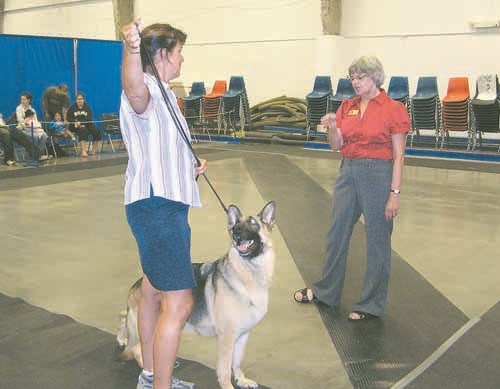The winner of two Best In Show placings at the Shamrock Kennel Annual Dog Show says the sport is all about the dogs. "It's not about the person showing the dog," says Jacquelyn Fussell, from Red Deer, Alta.
"It's quality time with my dog. It's quality time with other people's dogs that I show as well."
The show was held in Yorkton at the Gallagher Centre from August 20 to 22.
Hemi, an Irish Water Spaniel, is the female dog Fussell showed. She says winning two of the six Best In Shows of the entire competition was "overwhelming," but that she was "very grateful." Hemi's registered name is Finnibones Cool The Engines.
Fussell has been breeding various breeds for 30 years, but Irish water spaniels for 25 years. She has shown all over North America, including Westminster, New York.
Spectators at the show not only watched the competitions, but saw up close the preparation entrants put into the dogs. "Grooming usually lasts an hour before going into the ring," Fussell says. Every second day she performs conditioning with Hemi for at least an hour to an hour and a half, consisting of either "road work, water work, retrieving, or up and downhill ball playing."
The conformation competitions, in which the dogs are judged by their appearance, consisted of two shows being held at the same time each day, each consisting of seven separate competitions: the sporting group, terriers, hounds, toys, working group, herding group, and non-sporting group. The first place winners of these groups then competed at the end of each day for Best In Show, Reserve Best In Show, and Best Puppy In Show.
Rally obedience competitions were also held on Saturday and Sunday. Vice president of the club, Cathie Newans, says these competitions are based on the dog's intelligence and how well they are trained. "The dogs do basic obedience. They heel beside the handler, on leash and off leash; they have to do recalls; and they have to do sit stays and down stays as they move up. They do retrieve; they do jumps it gets exponentially harder each level that they go up."
Several judges attended, including Dorothy Hood, who started judging about five years ago.
She says each breed is judged accordingly. "It depends on the breed. Each breed has a written standard of perfection that describes the ideal characteristics, and it is against that written standard which we are judging the dogs. So when we get a group of german shepherds there are certain characteristics that are exclusive to the german shepherds. It's very important in the german shepherds to have very sound temperament because they are meant to work also a continuous steady trot and great endurance. In other breeds that might not be quite as important."
Hood has received her knowledge, she says, from "all over the place I probably initially started in 1980 when I started showing dogs myself. I've been breeding alaskan malamute for 35 years, and over the years I have been going to dog shows, I've watched other dogs, studied breed standards, read various books, talked to breeders, to other judges, and it's kind of an ongoing process you're always learning.
The show brought about 400 individual dogs to Yorkton, with about 1165 dogs in total that were judged.



